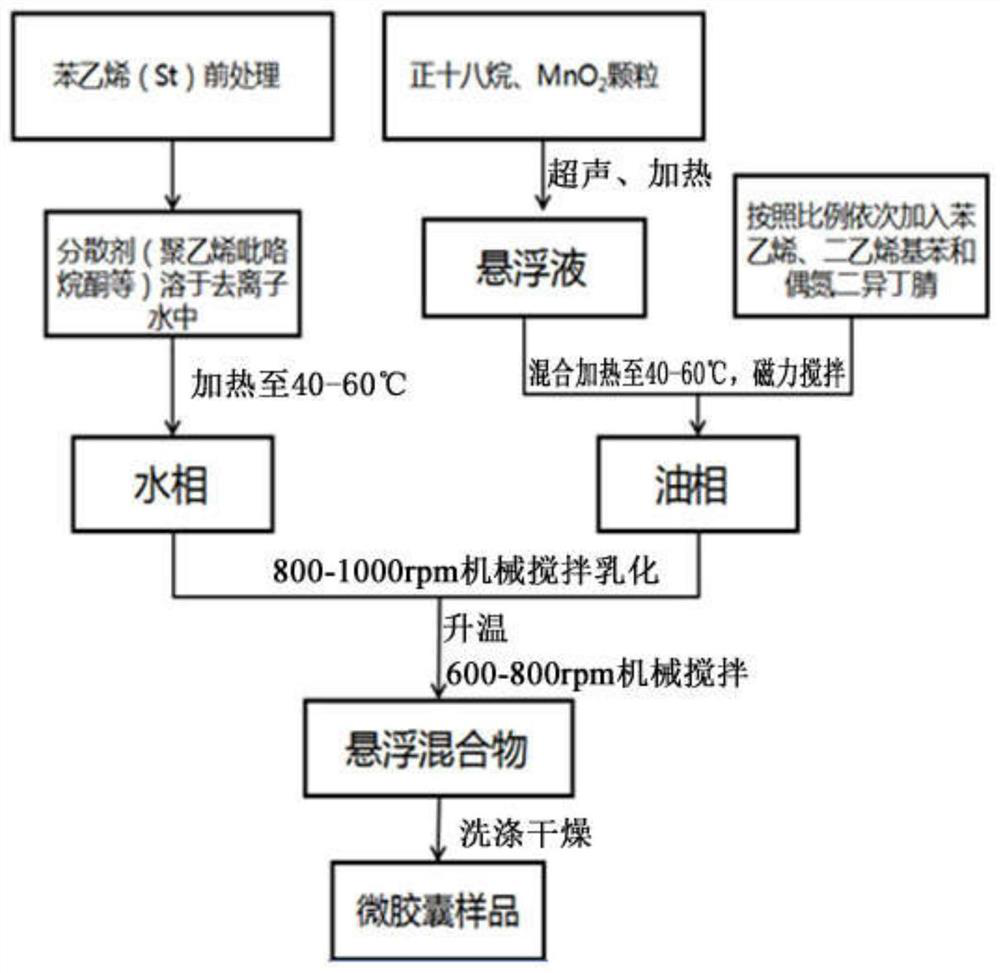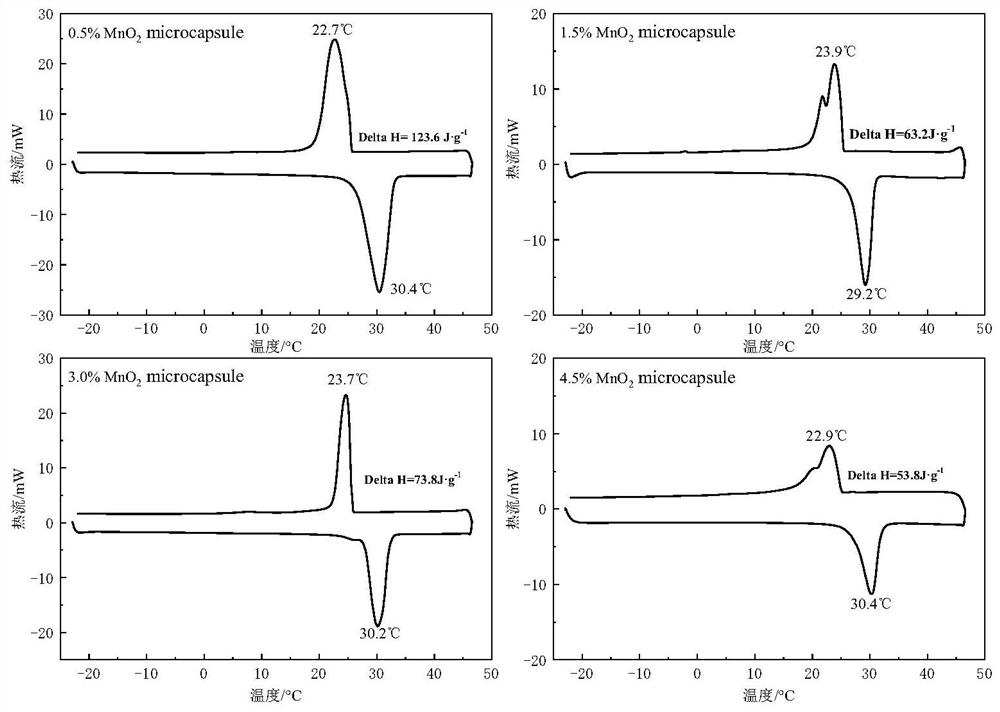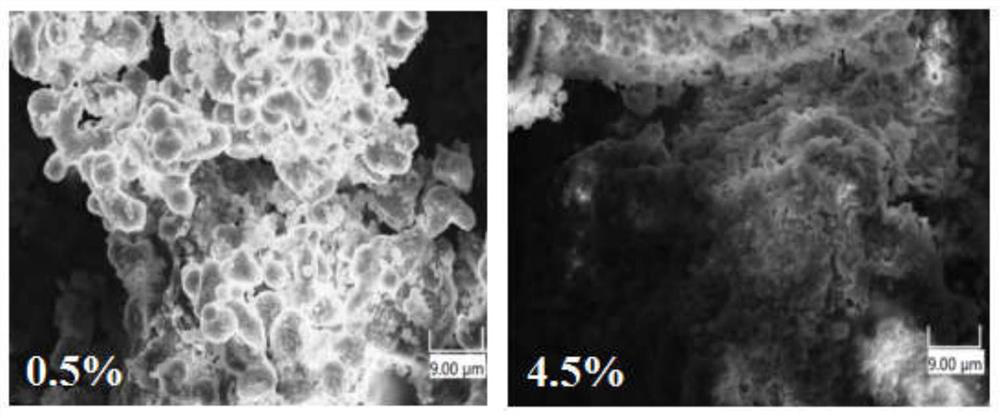A method of adding manganese dioxide particles to improve the thermal performance of n-octadecane/polystyrene phase change microcapsules
A phase change microcapsule, n-octadecane technology, applied in microcapsule preparations, chemical instruments and methods, heat exchange materials, etc., can solve the problems of easy agglomeration of nanoparticles and difficult to achieve adding effects, etc.
- Summary
- Abstract
- Description
- Claims
- Application Information
AI Technical Summary
Problems solved by technology
Method used
Image
Examples
Embodiment 1
[0031] In the examples, the mass of n-octadecane is 29.85 g, and the mass of manganese dioxide particles (self-made, tested with a Malvern 2000 laser particle size analyzer, with a particle size of about 20 μm) is 0.15 g. The amount of manganese dioxide particles added to the core material n-octadecane is 0.5%.
[0032] Use 10wt% NaOH solution to remove the polymerization inhibitor in styrene, add a small amount of anhydrous calcium chloride to dry. Dissolve 2g of dispersant polyvinylpyrrolidone in 240mL of deionized water and heat to 40°C to prepare an aqueous phase; at the same time, 29.85 g of n-octadecane and 0.15 g of MnO 2 The particles were placed in a beaker and sonicated at 30°C for 15 min to form a suspension; 30g n-octadecane / MnO 2 Suspension, 29.3mL styrene (St), 3.4mL divinylbenzene (DVB, cross-linking agent) and 0.7g azobisisobutyronitrile (AIBN, initiator) were sequentially added to the beaker and heated in an oil bath at 40°C, magnetic Stir for 20 min to make...
Embodiment 2
[0034] In the example, the mass of n-octadecane is 29.55 g, and the mass of manganese dioxide particles is 0.45 g. The amount of manganese dioxide particles added is 1.5% of the mass of the core material n-octadecane.
[0035] Use 10wt% NaOH solution to remove the polymerization inhibitor in styrene, add a small amount of anhydrous calcium chloride to dry. Dissolve 2 g of dispersant polyvinylpyrrolidone in 240 mL of deionized water and heat to 50 °C to prepare an aqueous phase; meanwhile, 29.55 g of n-octadecane and 0.45 g of MnO 2 The particles were placed in a beaker, and ultrasonicated at 40°C for 20 min to form a suspension; 30g n-octadecane / MnO2 Suspension, 29.3 mL styrene (St), 3.4 mL divinylbenzene (DVB, cross-linking agent) and 0.7 g azobisisobutyronitrile (AIBN, initiator) were added to the beaker in sequence according to the proportion and heated in an oil bath at 50 °C , magnetic stirring for 30 minutes to make the oil phase, when the temperature of the two-phase s...
Embodiment 3
[0037] In the example, the mass of n-octadecane is 29.13 g, and the mass of manganese dioxide particles is 0.87 g. The added amount of manganese dioxide particles accounted for 3.0% of the mass of the core material n-octadecane.
[0038] Use 10wt% NaOH solution to remove the polymerization inhibitor in styrene, add a small amount of anhydrous calcium chloride to dry. Dissolve 2g of dispersant polyvinylpyrrolidone in 240mL of deionized water and heat to 60°C to prepare an aqueous phase; at the same time, 29.13 g of n-octadecane and 0.87 g of MnO 2 The particles were placed in a beaker, and ultrasonicated at 50°C for 30 min to form a suspension; 30 g of n-octadecane / MnO 2 Suspension, 29.3mL styrene (St), 3.4mL divinylbenzene (DVB, crosslinking agent) and 0.7g azobisisobutyronitrile (AIBN, initiator) were added to the beaker in sequence according to the proportion and heated in an oil bath at 60°C , magnetically stirred for 40 minutes to make an oil phase, when the temperature ...
PUM
| Property | Measurement | Unit |
|---|---|---|
| encapsulation rate | aaaaa | aaaaa |
Abstract
Description
Claims
Application Information
 Login to View More
Login to View More - R&D
- Intellectual Property
- Life Sciences
- Materials
- Tech Scout
- Unparalleled Data Quality
- Higher Quality Content
- 60% Fewer Hallucinations
Browse by: Latest US Patents, China's latest patents, Technical Efficacy Thesaurus, Application Domain, Technology Topic, Popular Technical Reports.
© 2025 PatSnap. All rights reserved.Legal|Privacy policy|Modern Slavery Act Transparency Statement|Sitemap|About US| Contact US: help@patsnap.com



